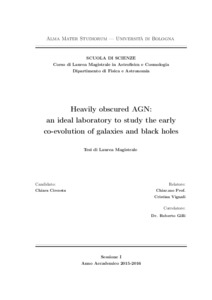Circosta, Chiara
(2016)
Heavily obscured AGN: an ideal laboratory to study the early co-evolution of galaxies and black holes.
[Laurea magistrale], Università di Bologna, Corso di Studio in
Astrofisica e cosmologia [LM-DM270]
Documenti full-text disponibili:
![[img]](http://amslaurea.unibo.it/11190/1.hassmallThumbnailVersion/Circosta_Chiara_tesi.pdf)  Anteprima |
|
Documento PDF
Disponibile con Licenza: Salvo eventuali più ampie autorizzazioni dell'autore, la tesi può essere liberamente consultata e può essere effettuato il salvataggio e la stampa di una copia per fini strettamente personali di studio, di ricerca e di insegnamento, con espresso divieto di qualunque utilizzo direttamente o indirettamente commerciale. Ogni altro diritto sul materiale è riservato
Download (6MB)
| Anteprima
|
Abstract
Obscured AGN are a crucial ingredient to understand the full growth history of super massive black holes and the coevolution with their host galaxies, since they constitute the bulk of the BH accretion. In the distant Universe, many of them are hosted by submillimeter galaxies (SMGs), characterized by a high production of stars and a very fast consumption of gas. Therefore, the analysis of this class of objects is fundamental to investigate the role of the ISM in the early coevolution of galaxies and black holes.
We present a multiwavelength study of a sample of six obscured X-ray selected AGN at z>2.5 in the CDF-S, detected in the far-IR/submm bands. We performed the X-ray spectral analysis based on the 7Ms Chandra dataset, which provides the best X-ray spectral information currently available for distant AGN. We were able to place constraints on the obscuring column densities and the intrinsic luminosities of our targets. Moreover, we built up the UV to FIR spectral energy distributions (SEDs) by combining the broad-band photometry from CANDELS and the Herschel catalogs, and analyzed them by means of an SED decomposition technique. Therefore, we derived important physical parameters of both the host galaxy and the AGN. In addition, we obtained, through an empirical calibration, the gas mass in the host galaxy and assessed the galaxy sizes in order to estimate the column density associated with the host ISM.
The comparison of the ISM column densities with the values measured from the X-ray spectral analysis pointed out that the contribution of the host ISM to the obscuration of the AGN emission can be substantial, ranging from ~10% up to ~100% of the value derived from the X-ray spectra. The absorption may occur at different physical scales in these sources and, in particular, the medium in the host galaxy is an ingredient that should be taken into account, since it may have a relevant role in driving the early co-evolution of galaxies with their black holes.
Abstract
Obscured AGN are a crucial ingredient to understand the full growth history of super massive black holes and the coevolution with their host galaxies, since they constitute the bulk of the BH accretion. In the distant Universe, many of them are hosted by submillimeter galaxies (SMGs), characterized by a high production of stars and a very fast consumption of gas. Therefore, the analysis of this class of objects is fundamental to investigate the role of the ISM in the early coevolution of galaxies and black holes.
We present a multiwavelength study of a sample of six obscured X-ray selected AGN at z>2.5 in the CDF-S, detected in the far-IR/submm bands. We performed the X-ray spectral analysis based on the 7Ms Chandra dataset, which provides the best X-ray spectral information currently available for distant AGN. We were able to place constraints on the obscuring column densities and the intrinsic luminosities of our targets. Moreover, we built up the UV to FIR spectral energy distributions (SEDs) by combining the broad-band photometry from CANDELS and the Herschel catalogs, and analyzed them by means of an SED decomposition technique. Therefore, we derived important physical parameters of both the host galaxy and the AGN. In addition, we obtained, through an empirical calibration, the gas mass in the host galaxy and assessed the galaxy sizes in order to estimate the column density associated with the host ISM.
The comparison of the ISM column densities with the values measured from the X-ray spectral analysis pointed out that the contribution of the host ISM to the obscuration of the AGN emission can be substantial, ranging from ~10% up to ~100% of the value derived from the X-ray spectra. The absorption may occur at different physical scales in these sources and, in particular, the medium in the host galaxy is an ingredient that should be taken into account, since it may have a relevant role in driving the early co-evolution of galaxies with their black holes.
Tipologia del documento
Tesi di laurea
(Laurea magistrale)
Autore della tesi
Circosta, Chiara
Relatore della tesi
Correlatore della tesi
Scuola
Corso di studio
Ordinamento Cds
DM270
Parole chiave
AGN,obscured,host galaxies,co-evolution
Data di discussione della Tesi
19 Luglio 2016
URI
Altri metadati
Tipologia del documento
Tesi di laurea
(NON SPECIFICATO)
Autore della tesi
Circosta, Chiara
Relatore della tesi
Correlatore della tesi
Scuola
Corso di studio
Ordinamento Cds
DM270
Parole chiave
AGN,obscured,host galaxies,co-evolution
Data di discussione della Tesi
19 Luglio 2016
URI
Statistica sui download
Gestione del documento:


 Login
Login
